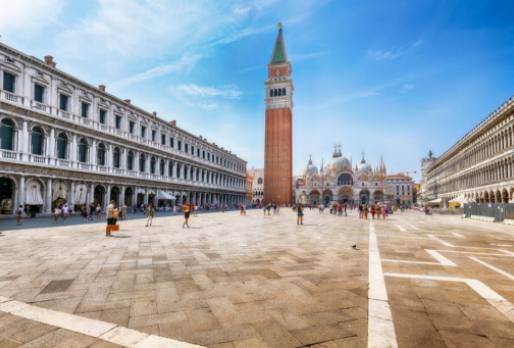The Venice Biennale has long been known as one of the most prestigious art exhibitions in the world, drawing artists and visitors from all corners of the globe. As the art world evolves and traditional boundaries are pushed, the future of the Venice Biennale is being shaped by a number of innovative initiatives and expectations. From sustainability efforts to embracing diversity and accessibility, as well as the incorporation of AI and robotics into artistic endeavors, the Biennale is at the forefront of change and progress in the art world.

Sustainability Initiatives: Reducing the Environmental Impact of the Venice Biennale
The Venice Biennale, one of the most prestigious art events in the world, has been taking steps towards reducing its environmental impact through various sustainability initiatives. With thousands of visitors flocking to Venice every year to experience the latest in contemporary art, the Biennale has recognized the importance of addressing its carbon footprint and promoting eco-friendly practices.
One of the key initiatives implemented by the Venice Biennale is the adoption of sustainable practices in its exhibition spaces. By using energy-efficient lighting, recycling materials, and reducing water consumption, the Biennale aims to minimize its environmental impact and set an example for other cultural events to follow. Additionally, the Biennale encourages participating artists to consider the sustainability of their works, whether through the use of recycled materials or the incorporation of environmentally-friendly themes in their art.
In recent years, the Venice Biennale has also made strides in promoting eco-friendly transportation options for visitors. From encouraging the use of public transportation to providing bike-sharing services, the Biennale aims to reduce the carbon emissions associated with travel to and from the event. By raising awareness about the environmental impact of transportation and offering alternatives, the Biennale demonstrates its commitment to sustainability and inspires visitors to make more eco-conscious choices.
Furthermore, the Venice Biennale has been actively engaging with local communities and environmental organizations to promote environmental conservation in Venice and beyond. Through collaborations with sustainability-focused initiatives and the integration of environmental themes in its programming, the Biennale is leveraging its platform to advocate for a more sustainable future.
As the Venice Biennale continues to evolve and adapt to the changing artistic landscape, its commitment to sustainability remains at the forefront of its priorities. By implementing innovative sustainability initiatives and championing eco-friendly practices, the Biennale is not only reducing its environmental impact but also inspiring a new generation of artists and art enthusiasts to prioritize environmental stewardship in their creative endeavors.
Inclusive Art: Embracing Diversity and Accessibility at the Venice Biennale
The Venice Biennale has long been a prestigious event in the art world, showcasing the work of talented artists from around the globe. In recent years, there has been a greater emphasis on embracing diversity and promoting accessibility within the Biennale. This shift towards inclusive art has led to a more varied and representative array of artworks on display, ensuring that all visitors can feel welcome and included in the experience.
One of the ways in which the Venice Biennale has embraced diversity is by actively seeking out artists from a wide range of backgrounds and cultures. This has resulted in a more diverse and inclusive selection of art, with pieces that speak to a variety of perspectives and experiences. By showcasing the work of artists from marginalized communities, the Biennale has helped to amplify voices that may have previously been overlooked in the art world.
In addition to highlighting artists from diverse backgrounds, the Venice Biennale has also taken steps to make the event more accessible to all visitors. This includes providing accommodations for individuals with disabilities, such as wheelchair access and sign language interpreters. The Biennale has also worked to ensure that its venues are welcoming and inclusive spaces, where visitors of all backgrounds feel comfortable and valued.
Overall, the Venice Biennale's embrace of diversity and accessibility has enriched the event, making it a more inclusive and representative showcase of contemporary art. By prioritizing inclusivity, the Biennale has opened its doors to a wider audience and broadened the scope of the art world, ensuring that all voices are heard and celebrated in this prestigious event.
Technological Advancements in Art: How AI and Robotics are Shaping the Venice Biennale
Technological advancements in art have been rapidly shaping the landscape of the Venice Biennale in recent years. Artificial intelligence (AI) and robotics are playing a significant role in revolutionizing the way artists create and present their works at the prestigious art event.
AI has enabled artists to explore new ways of expressing themselves and pushing the boundaries of traditional art forms. By harnessing the power of machine learning algorithms, artists can generate innovative and dynamic artwork that challenges viewers' perceptions and emotions. AI-generated art has been featured prominently at the Venice Biennale, showcasing the intersection of technology and creativity.
Robotics have also played a key role in transforming the art world at the Venice Biennale. Artists are increasingly incorporating robotic elements into their installations, blurring the lines between the virtual and physical realms. From interactive robotic sculptures to autonomous art-making machines, robotics have opened up a whole new realm of possibilities for artists to experiment and engage with audiences in novel ways.
The integration of AI and robotics in art has not only expanded the creative possibilities for artists but has also sparked important discussions about the role of technology in shaping the future of art. As the Venice Biennale continues to embrace technological advancements, it will be fascinating to see how AI and robotics will continue to influence and shape the way we experience art in the years to come.
